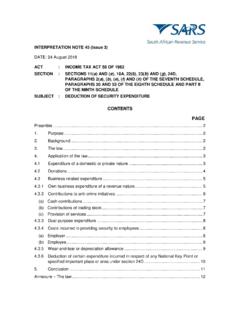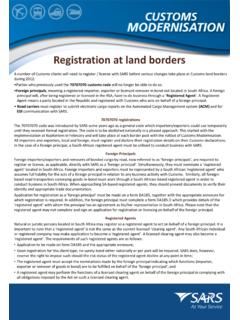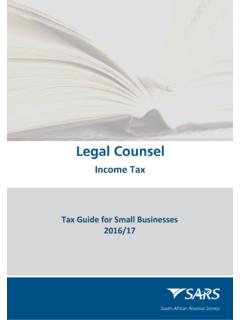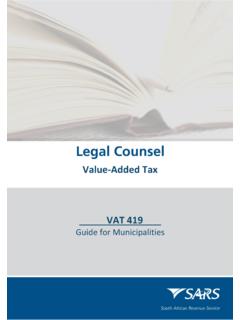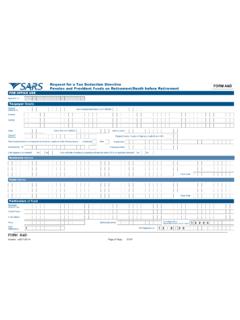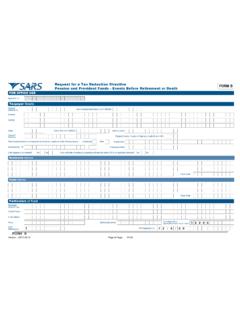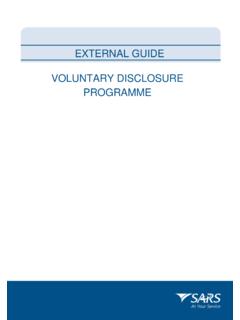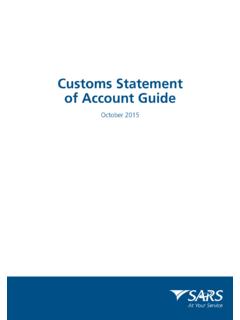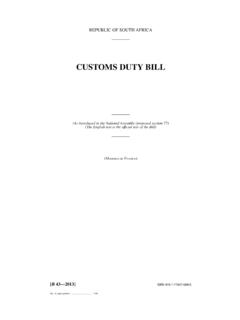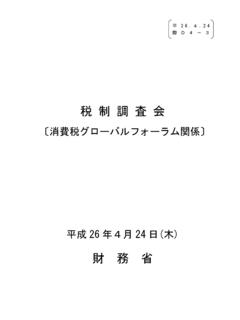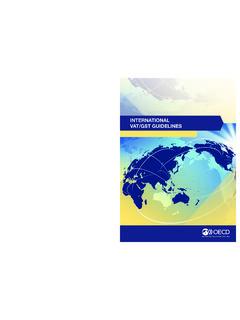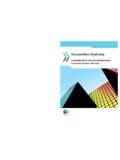Transcription of INTERPRETATION NOTE: NO. 70 ACT : VALUE …
1 INTERPRETATION NOTE: NO. 70 DATE: 14 March 2013 ACT : VALUE -ADDED TAX ACT NO. 89 OF 1991 (the VAT Act) SECTION : SECTION 1(1) DEFINITION OF THE TERMS ENTERPRISE , TAXABLE SUPPLY , INPUT TAX , DONATION AND CONSIDERATION SECTIONS 10(4) AND 10(23) SUBJECT : SUPPLIES MADE FOR NO CONSIDERATION CONTENTS PAGE Preamble .. 2 1. Purpose .. 2 2. Background .. 2 3. International characteristics and principles of VAT .. 3 Tax policy and legislative design .. 3 General principles and guidelines .. 4 Supplies made for no consideration .. 6 4. The law .. 8 5. Application of the law .. 9 Definitions, concepts and valuation rules .. 9 Definition of enterprise [section 1(1)] .. 9 Definition of the term consideration [section 1(1)] .. 15 Definitions of input tax and taxable supply [section 1(1)] .. 17 Definition of donation [section 1(1)] .. 17 VALUE of supply [section 10(23)].
2 19 Adjustments [section 18(1)] .. 19 Supplies made for no consideration .. 20 Introduction .. 20 General 20 Promotional products and other free supplies .. 21 Supplies between connected persons .. 22 Corporate social responsibility (CSR) expenses .. 23 Fringe benefits .. 24 Municipalities .. 24 Public authorities, public entities and designated 26 2 Associations not for gain .. 26 Welfare organisations .. 28 Public benefit organisations (PBOs) .. 28 6. Conclusion .. 30 Annexure A The law .. 32 Annexure B Listed welfare activities .. 36 Annexure C Extracts from the VATCOM Report on the government s draft VALUE -Added Bill in regard to the VAT treatment of associations not for gain and welfare organisations .. 38 Preamble In this Note references to sections are to sections of the VAT Act unless otherwise stated and any word or expression bears the meaning ascribed to it in the VAT Act.
3 1. Purpose This Note serves to set out the legal framework for the VAT treatment of supplies of goods or services which are made by vendors for no consideration in certain circumstances; and provide guidance to vendors, on whether input tax may be deducted in respect of any VAT incurred on goods or services acquired to make supplies for no consideration; and output tax must be declared on any goods or services supplied for no consideration. 2. Background The definition of enterprise in section 1(1) is one of the most important definitions in the VAT Act. Its main purpose is to set out as clearly as possible, the type of persons, activities and supplies which are intended to form part of the tax base, as well as those that are meant to be excluded. In terms of paragraph (a) of this definition, there is a general requirement that enterprises participating in the VAT system must charge a consideration (price) for the goods or services they supply.
4 The implication of not meeting this requirement is that supplies made for no consideration are not made in the course or furtherance of an enterprise, and hence, will not be a taxable supply. However, there are many different circumstances under which enterprises will, for purely commercial reasons, make a supply without charging a consideration. This raises the question as to whether there are certain circumstances under which a supply for no consideration may be regarded as a taxable supply, and consequently, whether it will be possible for the supplier to deduct input tax on any expenses1 incurred for the purpose of making those supplies. 1 Any reference to expenses in this Note in the context of considering whether input tax is deductible or not, is assumed to include VAT at the standard rate unless otherwise indicated.
5 3 The ability to correctly characterise a particular supply as being taxable or not is important because the vendor will generally have a right to deduct the VAT incurred on any goods or services acquired for the purposes of making taxable supplies, but will not be able to do so if the supplies are exempt, out-of-scope, or in connection with any other non-taxable activities conducted by the vendor. To fully understand the VAT treatment of supplies made for no consideration under the South African VAT system, it is necessary to understand the underlying policy framework which influences the design of the VAT system, as well as the general international characteristics and principles upon which a VAT system of taxation is based. This is important because although the different countries that have VAT (or goods and services tax (GST) as it is known in some other countries) have very similar core features, there are often a number of differences in the detail of how the features and designs of those systems apply.
6 The approach of this Note is therefore to set out the framework in 3 below, of some of the international principles and characteristics of VAT which affects the legislative design of a VAT system in general before dealing with the treatment of these supplies under the South African VAT system in 5. Refer also to Annexure C which includes a number of extracts from the VATCOM Report2 setting out the original policy framework of VAT in South Africa, particularly as it relates to associations not for gain and welfare Readers who are already familiar with the principles and concepts dealt with in 3 should proceed to the wording of the relevant provisions of the VAT Act in Annexure A, or the INTERPRETATION of those provisions in 5. 3. International characteristics and principles of VAT Tax policy and legislative design The main purpose of VAT4 is to raise revenue for government.
7 VAT legislation requires any person that conducts taxable activities5 exceeding the prescribed registration threshold VALUE to register with the tax authorities as a vendor6 and to collect and pay VAT on the consideration received for taxable supplies of goods or services made by the Generally, in a broad-based tax such as VAT, concessions and exceptions are kept to a minimum so as not to erode the tax base and its potential to generate revenue. South Africa applies the invoice-based credit method of VAT (also known as the subtraction method) which is used in most other countries. Under this method, credit is granted for the VAT incurred on taxable enterprise inputs (input tax) which may be subtracted from the tax collected on taxable supplies made (output tax). The VAT payable by the vendor to the tax authorities is the difference between the output tax 2 The VALUE -Added Tax Committee (VATCOM) was a committee consisting of members from the private and public sectors, appointed by the Minister to consider the comments and representations made by interested parties in 1991 before VAT was introduced.
8 3 Although there have been a number of amendments to the VAT Act over the years, the policy framework has essentially remained unchanged since the introduction of VAT in 1991. 4 For ease of reading, in 3 of the Note, which deals with international VAT and GST principles, any reference to the acronym VAT includes reference to the acronym GST which may be used in other countries as a national tax that embodies the basic features of a VALUE -added tax. 5 This is commonly referred to as a business or enterprise . 6 Alternative terms used in some countries include taxable person or registered person . 7 In some countries reference is made to a business or a person that conducts economic activities . 4 and the input tax in any particular tax period. In a situation where input tax exceeds output tax in a tax period, the vendor is entitled to a refund of the difference.
9 As refunds may be a regular feature of certain businesses,8 this aspect is incorporated into the mechanics and design features of the VAT legislation. In any VAT system, the tax base consists mainly of persons that conduct commercial activities which usually have a profit motive,9 but it also includes the activities of entities that are not necessarily focused on profitability. The underlying assumption is that most businesses are carried on for the purpose of making a profit on an ongoing basis, and will usually be in a net VAT payable situation, thus generating the required revenue. This is despite the fact that certain vendors participating in the VAT system may be entitled to refunds on a regular basis. General principles and guidelines In terms of the guidelines10 issued by the Organisation for Economic Co-Operation and Development (OECD), a VAT is considered to have the following general characteristics: It is a tax on consumption, paid, ultimately, by final consumers.
10 The tax is levied on a broad base; In principle, business should not bear the burden of the tax itself since there are mechanisms in place that allow for a refund of the tax levied on intermediate transactions between firms. The system is based on tax collection in a staged process, with successive taxpayers entitled to deduct input tax on purchases and account for output tax on sales. Each business in the supply chain takes part in the process of controlling and collecting the tax, remitting the proportion of tax corresponding to its margin, that is, on the difference between the VAT paid out to suppliers and the VAT charged to customers. In general, OECD countries with VALUE -added taxes impose the tax at all stages and normally allow immediate deduction of taxes on purchases by all but the final 8 Examples include exporters and other suppliers which mainly make supplies which are subject to VAT at the zero rate.
